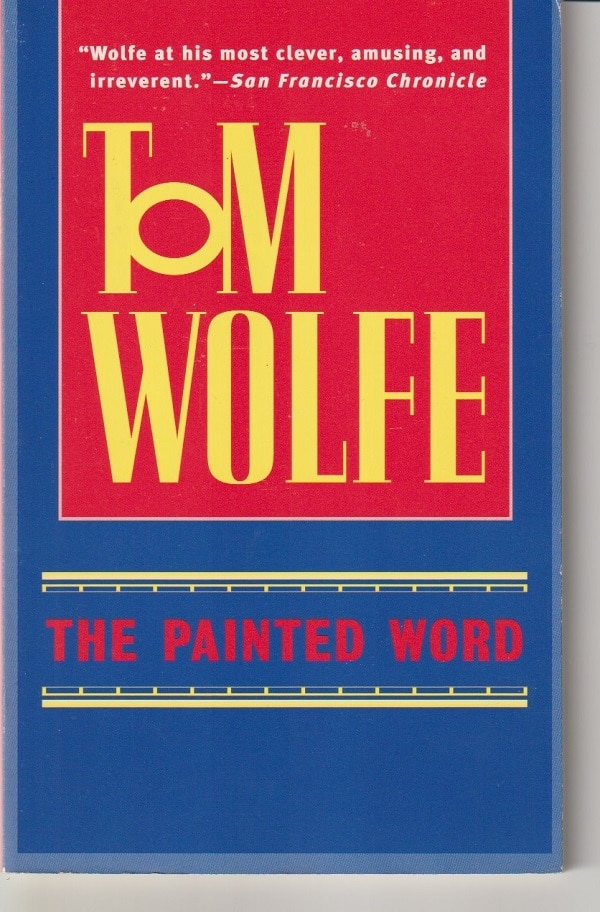The Painted Word is an essay by Tom Wolfe, originally published in Harper’s Magazine in April, 1975 and then released in June of that year as a slim book, 99 pages in the edition I just read.
In it, Wolfe, then a wunderkind of what was beginning to be called the New Journalism, skewered the pomposity and insularity of the world of Modern Art with sharp observation, deep research and deadpan wit.
Today, at a distance of 45 years, it seems to me that, for all his prodigious talent, Wolfe was grabbing at low-hanging fruit.
The 10,000
Wolfe himself makes the point that, by his estimation, exclusive of artists, there were in 1975 only about 10,000 people — members of le monde, i.e., the smart set — in the art world. These are the people, rich and well-connected and hip, who determined what sort of art was in and what was passe.
Not for the general public, although museums would end up purchasing some of this art to chronicle the shifting fashions.
 No, the general public wasn’t in the picture.
No, the general public wasn’t in the picture.
The decisions these 10,000 people made about the latest fad in art was only for themselves. They decided that, for instance, Post-Painterly Abstraction was, for this moment, the thing, and then they listened to their own decisions and acted accordingly.
They were talking to themselves.
Because artists, for any number of reasons, felt the need to explore new ways of creating art and because those who were caught up in buying, selling and promoting art always needed new product, there were seemingly endless new theories to explain the changing of the styles.
Lots of talking. Lots of posturing. Lots of theories.
The 90
Wolfe also makes the point that, of the 10,000 denizens of the art world, only about 2,000 were collectors. Of those, only about 300 collected the latest new stuff, and only about 90 of them lived in the U.S.
So, he was writing about an American market catering to enough rich people to fill maybe one rush-hour Chicago Transit Authority subway car (not that they would ever ride one).
These members of le monde didn’t care about the hoi polloi, and the hoi polloi didn’t care much about them, although there was a spill-over into the public realm in terms of how modern art was raided by fashion designers to come up with new dress patterns, colors and schemes.
In one way, the general public was interested in these 10,000 people — as celebrities who could be seen in newspaper and magazine photographs looking beautiful in beautiful clothing and who provided fodder for tsk-tsking with their scandalous ways.
Theories, schmeories, the average Jane or Joe didn’t care.
Yet, Wolfe goes on for nearly 100 pages skewering those 10,000 who were eating up all those theories.
The neatest thing
The thing is: Wolfe wasn’t writing for the general public, either.
He was writing for the cognoscenti, predominately the New York cognoscenti, the self-proclaimed arbiters of everything intellectual.
In fact, this group, across the globe, included the 10,000 people of the art world, and, in Wolfe’s book, we have a case of one group of these arbiters making fun of another group.
As if the cognoscenti weren’t, in their own way, pompous and insular.
When writers proclaimed or accepted the label of New Journalism for their work, wasn’t that akin to artists proclaiming or accepting the label of Post-Painterly Abstraction for their work?
On every page, it is as if Wolfe is engaging in a nod-nod, wink-wink with other literati insiders.
First, he is saying: Look how silly these others are (not at all like us).
Second, he is saying to his fellow insiders: Aren’t I just the neatest thing with the way I’ve wielded my words to slice and dice these fools?
Patrick T. Reardon
5.29.20
Written by : Patrick T. Reardon
For more than three decades Patrick T. Reardon was an urban affairs writer, a feature writer, a columnist, and an editor for the Chicago Tribune. In 2000 he was one of a team of 50 staff members who won a Pulitzer Prize for explanatory reporting. Now a freelance writer and poet, he has contributed chapters to several books and is the author of Faith Stripped to Its Essence. His website is https://patricktreardon.com/.
